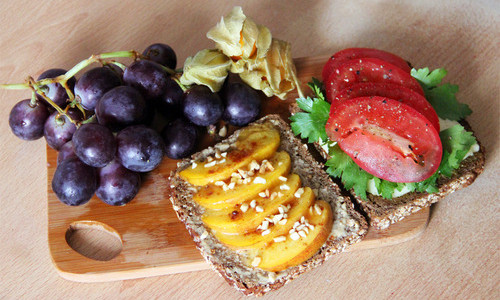Admittedly, I prefer to chew my food, not drink it. There is even some research to show that taking in the same amount of calories in liquid versus solid form can easily lead to consuming more calories later. Liquids just don’t satisfy the same way solid food can, in particular due to the fact that food is stripped of some beneficial nutrients – in particular, the fiber. I realize this preference for chewing is not held by all and I admit smoothies can be quick and easy solutions for people who might otherwise be skipping meals (or not eating their veggies).
Please don’t be fooled though. Just because smoothies contain fruits and vegetables does not automatically make them “healthy”. Simply containing healthy ingredients does not a healthy smoothie make. Nutrient composition (and density) is crucial. Just as well balanced meals and snacks make up a healthy diet, smoothies need to be just as well balanced. If you wouldn’t eat 3 pieces of fruit for a meal or a snack, you shouldn’t be drinking them together in your smoothie either. Think of your smoothies as a meal or snack in liquid form – it’s a more convenient way to get the nutrients you need.
Here are some tips for creating smoothies the healthy (and waistline saving) way:
- Use a liquid other than juice as your base. Juice has a ton of sugar and adds little nutritional value. In fact, you should never even consider using juice. It has zero benefits. I like to use 1 cup unsweetened almond milk or soy milk as my base (soy will provide additional protein and a little fat).
- Use 1 serving of fruit to add natural sweetness. You reap the benefits of the natural fiber fruit contains plus all those good vitamins, minerals and antioxidants. A serving is 1 modestly sized whole fruit (like an apple, pear, orange, or banana), 1 cup chopped fruit or up to 1 ½ cups berries. Frozen fruit is another option. It’s convenient, economical and means you don’t need to add ice (which tends to water down the flavor). Be sure to check the label and stick to the recommended serving size. I also like to use a teaspoon of raw agave syrup or 1 date to add a little extra sweetness.
- Be sure to add some fat and protein. These take longer to digest, will help fill you up longer and also slow sugar absorption. The same goes for fiber, which most of us don’t get enough of. Try 1 Tbsp nut butter, ¼ avocado, or ½ cup plain greek yogurt or cottage cheese
- Portions are KEY. Figure out whether this smoothie is replacing breakfast or being used as a snack and portion accordingly.
Here’s a simple recipe I use. Feel free to play around with the ingredients if it’s not your jam (I won’t be offended). Change up the fruit, milk and nut butters, and if you really feel like living on the edge, add a couple tablespoons of oats for some texture and B vitamins.
2-3 cups raw baby spinach**
1 cup unsweetened vanilla almond milk
1-2 Tbsp almond butter
1 cup frozen strawberries or blueberries
1 date, pitted
Optional: 1-2 Tbsp protein powder (I like Vega or Sunwarrior) or ½ cup low fat plain greek yogurt
Throw ‘em all in your blender, Vitamix or Nutribullet and blend until desired consistency.
** Disclaimer: I’m a spinach girl. I know kale is all the rage, but spinach has my heart (sorry kale). Spinach is a nutrition powerhouse – it’s got fiber, its got protein (yup!) and a ton of important vitamins and minerals, including iron, folate, and calcium. It’s my salad green of choice so obvi it would go in my smoothies too.

